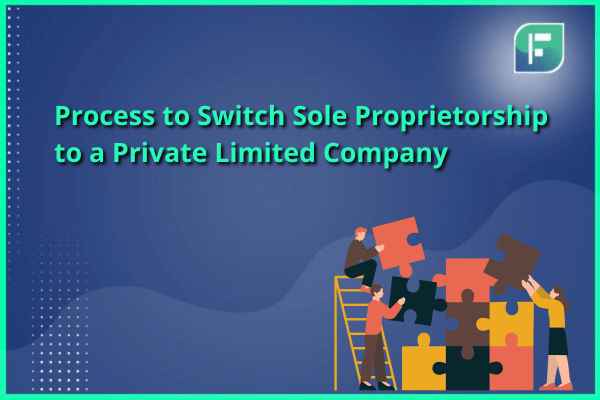If you are in the business field you must have heard that sole proprietorship firm registration is the easiest way to start a business. This has been said because of the various reasons and out of which one is that it’s very easy to switch sole proprietorship to a private limited company. Not just a private limited company it can be switched in any other form quite easily. In the present time the most preferred choice of entrepreneurs is private limited company registration. But the registration and compliance cost of such an entity is really high and sometimes one cannot afford it in the initial stage of business. Hence it has been suggested to start with sole proprietorship and once the right time comes you can switch sole proprietorship to a private limited company. To learn more about the same, keep reading the blog till its end.
What is a Sole Proprietorship Firm?
A sole proprietorship firm is any company founded by one person that lacks attributes such as perpetual succession, independent legal entity status, limited liability, or status of juristic person. When it comes to little enterprises, these companies are the best. Because these businesses don’t adhere to the same strict procedures as corporate bodies, it has been argued. These are low-cost organizations with an extremely low compliance rate. They don’t put any strain on the proprietor, who runs these entities alone. These kinds of organizations allow people to conduct business freely rather than adding burdens. A sole proprietorship can often be recognized by the GST, the Shop and Establishment Certificate, the Udyaog Aadhaar, etc., therefore there is usually no need to register them. Therefore, it has been advised that small business owners launch their companies as sole proprietorships based on the information provided above.
What is a Private Limited Company?
A company which has been registered under the Companies Act of 2013 with the help of Ministry of Corporate Affairs with minimum paid up capital of Rs. 1 lakh with minimum two directors and maximum 200 members is called Private Limited Company. Such entities have qualities like separate legal entity, limited liability, status of juristic person, perpetual succession, proper management and oppression etc.
How to Switch Sole Proprietorship to a Private Limited Company?
In order to switch sole proprietorship to a private limited company you need to follow the steps given below:
Check the Requirements to Switch Proprietorship to a Pvt. Ltd. Company
- For the Private Limited Company, a minimum of two directors are required.
- There must be a minimum of two shareholders, of which the proprietor becomes one.
- Directors are required to obtain a Digital Signature Certificate (DSC) and a Director Identification Number (DIN).
- Drafts of the new company’s articles of association (AOA) and memorandum of association (MOA).
- Declare the Private Limited Company’s registered office address.
- Assign shares to the shareholders after deciding on the share capital structure.
- Obtain the conversion’s approval from the current creditors.
- Provide an inventory of the proprietorship’s possessions and debts.
- Acquire tax clearances and guarantee adherence to tax laws.
- Call a board meeting to discuss and approve the conversion and associated issues.
Documentation to Switch Sole Proprietorship to a Private Limited Company
- Verification of Address and Identity
- Pictures of the directors
- Evidence of the Registered Office
- Landlord’s NOC (if the office is rented)
- Utility Bill (if you own the office)
- Number for Director Identification that is DIN
- Certificate of Digital Signature that is DSC
- Letter of Approval for Name
- Association Memorandum that is MOA
- The Association’s Articles that is AOA
- The Declaration of Non-Acceptance
- Directors’ Assent
- Asset and Liability Statement
- Certificates of Tax Registration
Process to Switch Sole Proprietorship to a Private Limited Company
- Make a clear decision to switch the business structure.
- Plan the transition considering legal, financial, and operational aspects.
- Identify shareholders and directors for the new company.
- File the incorporation documents, including MOA, AOA, and other necessary forms with the MCA.
- Once approved, obtain the Certificate of Incorporation for the Private Limited Company.
- Apply for PAN and TAN for the new company.
- Open new bank accounts for the Private Limited Company.
- Ensure compliance with other statutory requirements.
- Document the transfer of assets and liabilities from the sole proprietorship to the new company.
- Inform stakeholders, including customers, suppliers, and employees, about the switch.
- Complete formalities for closing the sole proprietorship, including informing relevant authorities.
- Obtain any necessary approvals from regulatory bodies.
- Maintain records of all documents and filings for future reference.
- Consider seeking professional assistance, such as legal and financial advice, to ensure a smooth transition.
Conclusion
To switch sole proprietorship to a private limited company is a strategic move that offers distinct advantages. While a sole proprietorship is easy to start and has minimal compliance, transitioning to a private limited company brings benefits like limited liability, a separate legal entity, and the ability to attract more capital. The process to switch sole proprietorship to a private limited company involves careful planning, compliance with legal requirements, and documentation, including obtaining the necessary approvals and informing stakeholders. Although the initial registration and compliance costs are higher for a private limited company, the move is often considered a prudent step for businesses aiming for long-term growth and scalability. Entrepreneurs are advised to assess the right time for this transition and seek professional guidance to navigate the process smoothly.






